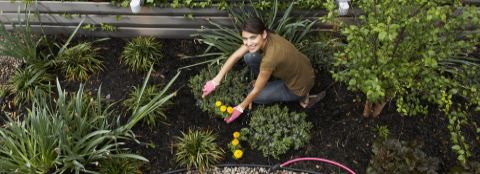April Southern Garden Checklist

Garden Care:
It’s time to get busy cleaning up your garden.
- Remove and compost any stems and seedpods left standing for winter.
- Mark the location of late emerging perennials like butterfly weed and hardy hibiscus to avoid damaging or accidentally weeding them out.
- Apply a slow-release low nitrogen fertilizer like Milorganite® to perennial gardens if you haven't yet this spring.
- Pinch mums and aster back to 6 inches now through early July. Pinch out the top few inches of bee balm, autumn joy sedum, Joe-pye weed and other late summer and fall bloomers that tend to flop.
- Watch for and control aphids as needed. Use a strong blast of water to dislodge these pests or spray with insecticidal soap to control larger populations.
- Prune spring flowering shrubs, as needed, when their blossoms fade.
- Remove one third of the older stems to ground level on multi-stemmed shrubs like forsythia, quince and mockorange. Reduce the height of remaining stems by one third as needed.
- Thin plantings of beets, carrots, Swiss chard and turnips. Make sure each remaining plant has room to grow and reach full size.
Planting Outdoors :
- Plant bean, corn, cucumber and southern pea seeds directly in the garden after the danger of frost has passed and soil has warmed. Planting in cold soil can result in poor germination. Wait for the soil temperatures to reach 75 degrees to plant okra seeds.
- Move eggplant, peppers, summer squash, and watermelons into the garden once the danger of frost has passed and night temperatures remain in the 50’s.
- Plant seeds of cosmos, marigolds, zinnias and other warm-season annuals directly in the garden, several weeks after the last frost and once the soil has warmed.
- Move Easter Lilies outdoors after the danger of frost has passed. Plant in full-sun and well-drained soil.
- Plant gladiolus corms 4 inches deep, every two weeks from mid spring throughout mid July. You’ll have continuous bloom in the garden and cut flowers for your bouquets.
- Plant container and balled and burlap trees and shrubs. Mulch the soil around the plants being careful not to bury the trunk or stems. Make sure to water thoroughly whenever the top few inches of soil are crumbly but moist.
Garden Harvest:
- Harvest established asparagus plantings when spears are 6 to 8 inches long. Harvest four-year and older plants for a total of six to eight weeks.
- Harvest established rhubarb plants for eight to ten weeks. Pull or cut the leafstalks from the plant when 12 to 15 inches tall, thick and crisp. Remove the leaf (its toxic) and only use the stalk.

